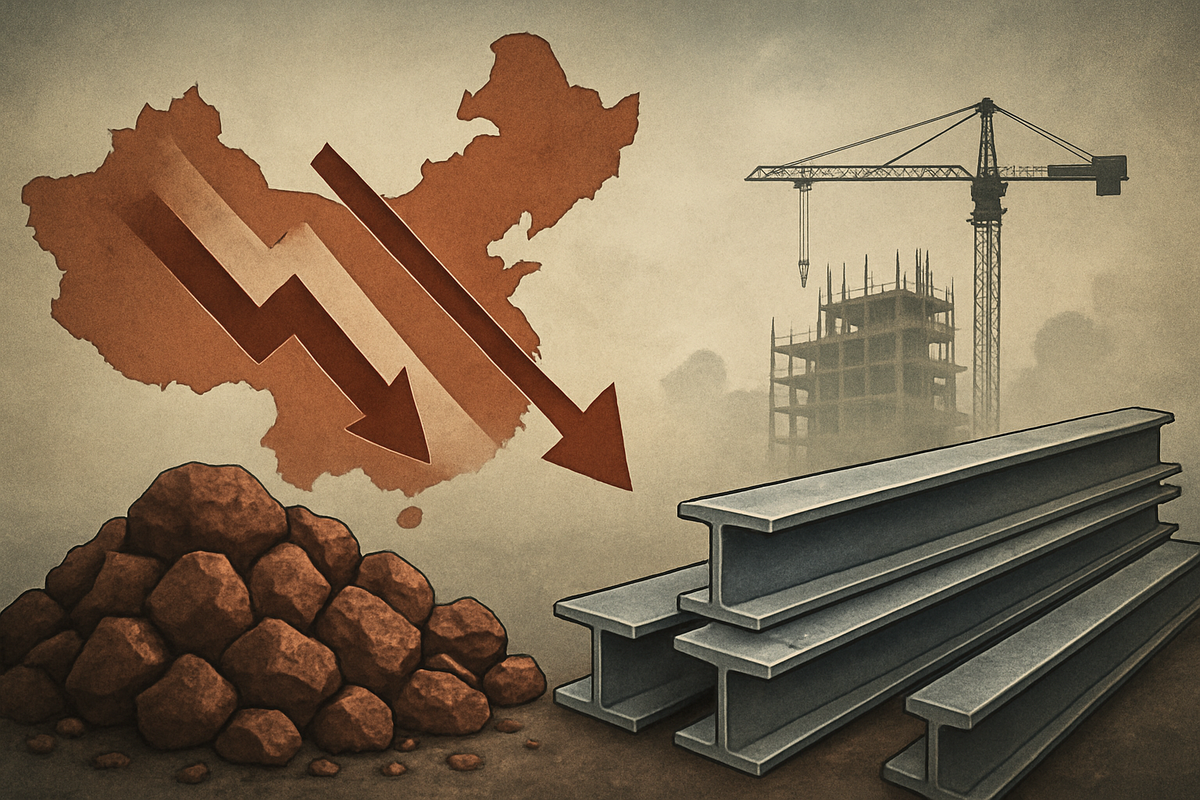
China's prolonged economic slowdown, exacerbated by a struggling property sector and subdued domestic consumption, is sending significant ripple effects across global commodity markets, with base metals and particularly iron ore bearing the brunt of reduced demand. As the world's largest consumer of raw materials, China's decelerating growth has translated into plummeting prices and surging inventories for crucial industrial inputs, signaling a challenging period for the global mining and manufacturing sectors.
The immediate implications are stark: a notable reduction in global demand for industrial metals and a subsequent sharp decline in their prices. Iron ore, a cornerstone for steel production heavily reliant on construction and infrastructure, finds itself in a particularly precarious position. The slowdown is not merely cyclical but appears to be a structural rebalancing of China's economy, moving away from its previous infrastructure-heavy growth model, which has profound and lasting consequences for commodity markets worldwide.
Detailed Coverage: China's Economic Contraction and Its Commodity Fallout
China's economy is navigating a complex period of deceleration, marked by an annualized GDP growth rate of 4.8% in the third quarter of 2025, a continued decline from earlier in the year. Projections from the World Bank and OECD suggest further moderation in 2025, with forecasts around 4.3% to 4.5%. This downturn is primarily attributed to a persistent slump in the real estate industry, weak domestic demand, and the lingering impacts of the pandemic. Efforts by the Chinese government to stimulate the economy through fiscal policies and quantitative easing have largely fallen short of reigniting robust domestic demand, as consumer and investor confidence remain low amidst a credit crunch stemming from the property crisis. Trade tensions, particularly with the US, have also contributed to reduced demand for Chinese exports.
The property sector's woes are at the heart of the crisis for iron ore. Accounting for approximately 26% of China's total steel consumption, the collapse of this sector—evidenced by record-high property inventories, stalled construction projects, and plummeting new-home prices—represents a significant structural drag on demand. Investment in China's real estate sector fell 12.9% in the first eight months of 2025, with new home construction starts anticipated to decline further. This has directly impacted steel production, with Chinese steel producers implementing widespread output cuts due to margin compression and operational losses. Crude steel output fell 9.2% year-on-year in June 2025, marking the largest decline in a decade.
Consequently, iron ore prices have suffered dramatically, falling by 55% since 2021 to around $100 per ton. Futures contracts on China's Dalian Commodity Exchange and the Singapore Exchange have hit multi-month lows. Compounding the issue are surging iron ore inventories at major Chinese ports, which reached nearly 138.5 million tons as of November 7, their highest levels since March 21. This accumulation of stock, despite declining global iron ore shipments, highlights a significant disconnect between available supply and diminished consumption. Beyond iron ore, other base metals like copper, nickel, lead, zinc, and aluminum have also seen significant price retreats, crushing margins for smelters and fabricators to levels not seen in over a decade. Key indicators like a contracting manufacturing Purchasing Managers' Index (PMI) and persistent factory-level deflation further underscore the pervasive weakness in industrial demand.
Company Impact: China's Economic Slowdown Weighs Heavily on Global Iron Ore and Steel Giants
China's economic deceleration, marked by reduced industrial activity and a struggling construction sector, is significantly impacting the revenues, profits, and stock performance of major global iron ore mining and steel production companies. As the world's largest consumer of iron ore and producer of steel, China's demand fluctuations send ripples across the entire industry, creating both vulnerabilities and pockets of resilience among key players.
Leading Iron Ore Mining Companies: The global iron ore market is largely dominated by a few multinational giants, including Rio Tinto Group (NYSE: RIO), Vale S.A. (NYSE: VALE), BHP Group Limited (NYSE: BHP), Fortescue Metals Group Limited (ASX: FMG), and Anglo American plc (OTCMKTS: AAUKF). Additionally, Cleveland-Cliffs Inc. (NYSE: CLF) and ArcelorMittal S.A. (NYSE: MT) have significant iron ore operations.
Major Steel Production Companies: The steel industry features numerous large players, with a strong concentration in Asia, such as China Baowu Group, ArcelorMittal S.A. (NYSE: MT), Nippon Steel Corporation, POSCO Holdings Inc, HBIS Group, Ansteel Group, and Shagang Group. North American players like Nucor Corp (NYSE: NUE) and United States Steel Corporation (NYSE: X) are also key.
China's position as the world's largest consumer of iron ore, importing over 70% of global seaborne supply, means its economic health is intrinsically linked to the profitability of iron ore miners. Similarly, its massive steel production and consumption directly influence global steel prices and demand. A slowdown translates directly into lower sales volumes and declining commodity prices for both iron ore and steel, compressing profit margins for producers globally. This often leads to negative stock performance as investors anticipate reduced earnings.
Companies most vulnerable to this downturn are pure-play iron ore miners heavily reliant on Chinese exports, such as Fortescue Metals Group (ASX: FMG), and Chinese domestic steel producers like China Baowu Group and Shagang Group, whose primary market is experiencing a severe downturn. High-cost producers and those with significant debt burdens will also struggle significantly. Conversely, more resilient companies include diversified mining giants like BHP Group (NYSE: BHP) and Rio Tinto Group (NYSE: RIO), which have broader commodity portfolios, and integrated steel producers like ArcelorMittal S.A. (NYSE: MT) and Cleveland-Cliffs Inc. (NYSE: CLF), which serve diverse end-markets and geographies, providing some insulation from China-specific headwinds. Companies with strong balance sheets and those focused on specialty steels or less cyclical markets also show greater resilience.
Wider Significance: A Structural Shift Reshaping Global Commodity Markets
China's economic slowdown is not merely a cyclical dip but represents a structural rebalancing with profound implications for global base metal and iron ore markets. This event fits into several broader industry trends that signal a new era for commodities.
Firstly, China is deliberately shifting from an investment-led, infrastructure-heavy growth model to one driven more by consumption and high-quality development. This fundamental transition inherently means a sustained reduction in demand for raw materials used in construction and heavy industry. Secondly, China's commitment to decarbonization and its dual-carbon goals (carbon peaking by 2030 and neutrality by 2060) are reshaping its industrial landscape, including efforts to curb steel output and promote greener steelmaking technologies. This trend will boost demand for "green metals" like copper and aluminum, while impacting the composition of iron ore demand, favoring higher grades suitable for cleaner processes. Thirdly, a growing focus on domestic resource security and scaling up metal recycling aims to reduce reliance on imports, further altering global supply chains.
The ripple effects are extensive, particularly for commodity-exporting nations like Australia and Brazil, whose economies are heavily dependent on iron ore exports to China. These nations face reduced export volumes, lower prices, and potential operational downscaling for their mining companies. Global mining giants like BHP Group (NYSE: BHP) and Rio Tinto Group (NYSE: RIO) must re-evaluate expansion plans and production schedules. Furthermore, the influx of cheap Chinese steel, stemming from reduced domestic demand, has led to increased protectionist measures globally, with countries imposing tariffs to safeguard their own steel industries, escalating global trade tensions. Historically, this period marks a definitive end to the "Commodity Super-Cycle" fueled by China's explosive growth, with analysts comparing it to past "steel winters" but noting the current downturn's potentially longer duration due to the structural nature of China's economic rebalancing.
What Comes Next: Navigating Volatility and Embracing Green Transition
In the coming months, the base metals and iron ore markets are expected to remain under considerable pressure. Iron ore prices, already at multi-month lows, are projected to continue facing headwinds due to persistent weak Chinese demand, burgeoning inventories, and seasonal slowdowns in construction. Analysts like JPMorgan anticipate supply surpluses in markets such as zinc and nickel, contributing to a bearish short-term outlook. The "export overdrive" by Chinese steel producers, offloading surplus steel into global markets, will continue to depress international steel prices.
Looking further ahead, the long-term outlook for iron ore appears challenging, with some forecasts predicting average prices could fall into the low $90s per ton by 2026 and beyond. This is largely due to China's structural economic shift and global decarbonization efforts, which favor electric arc furnaces (EAFs) using scrap steel over traditional blast furnaces reliant on iron ore. However, this transition simultaneously presents new opportunities for specific metals. China's 15th Five-Year Plan (2026-2030) emphasizes high-quality development and green transformation, which is expected to boost demand for metals crucial to green technologies, such as copper and aluminum for energy transition infrastructure, and nickel for electric vehicle (EV) batteries. Emerging economies like India and Southeast Asia also offer alternative, albeit slower, growth opportunities for steel and related commodities.
Strategic pivots are therefore essential for industry players. Mining companies must prioritize cost efficiency, diversify their commodity portfolios beyond iron ore (into "green metals"), and focus on producing high-grade iron ore suitable for cleaner steelmaking processes. Developing new market relationships in emerging economies is also paramount. Steel producers, particularly in China, will need to continue capacity rationalization, embrace green steel production methods (EAFs, hydrogen-based processes), and diversify their input sources to include more recycled steel scrap. The market will likely bifurcate, with strong demand for high-grade iron ore and "green" base metals, while lower-grade ores and traditional steel face sustained pressure.
Comprehensive Wrap-up: A New Era for Base Metals and Iron Ore
China's economic slowdown, fundamentally driven by its struggling property sector and a broader structural rebalancing, marks a watershed moment for global base metal and iron ore markets. The era of explosive, infrastructure-led demand that fueled a decades-long commodity supercycle is definitively over, giving way to a more nuanced and challenging market landscape.
The key takeaway is a sustained shift in demand dynamics. While overall demand for traditional construction-related metals like iron ore will face continued pressure, a new "green supercycle" is emerging for metals critical to the global energy transition. This includes copper and aluminum for renewable energy infrastructure and electric vehicles, and nickel for batteries. This divergence suggests a future where "old economy" metals may struggle, while "new economy" metals experience robust growth. Resource-dependent nations, particularly Australia and Brazil, face the imperative of economic diversification to mitigate the lasting impact of reduced Chinese demand.
Moving forward, the market will be characterized by ongoing price volatility for traditional base metals, tempered by the long-term growth prospects of green transition metals. Investors should closely watch for any significant new stimulus measures from the Chinese government, particularly those aimed at the property sector or a renewed focus on infrastructure. Key macroeconomic data from China, including industrial production and manufacturing PMIs, will continue to be crucial indicators. Additionally, monitoring global steel production levels, the growth of the green energy sector, and any new large-scale supply projects (like Simandou in Guinea) will be vital. For individual companies, assessing those with flexible cost structures, diversified operations, and strong exposure to "green" commodities will be paramount for navigating this transformative period.
This content is intended for informational purposes only and is not financial advice





